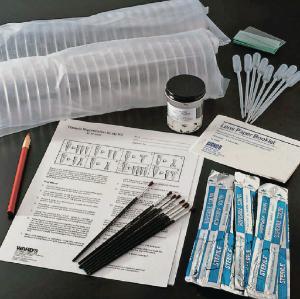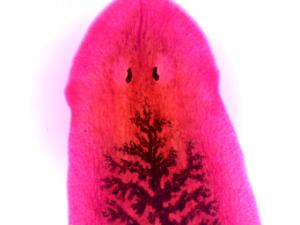How to teach with Planaria: A free guide for working with and caring for your live materials
Download this care guide for the facts on planaria reproduction and instructions for their collection, care, and feeding.
Introducing Ward’s How to Teach with Live Materials Series
Curious about teaching with live critters in your classroom, but not sure where to start? Or are you ready to incorporate a new type of specimen in your life science lessons but not sure which one is right for you? We’re here to help with our all-new How to Teach with Live Materials series of free guides. These free downloadable guides are packed with information and expert guidance from our in-house live materials lab technicians and biologists. You’ll get a thorough introduction to the wide world of living specimens and learn how to use them in your classroom to teach hands-on lessons that explore everything from life cycles, animal behavior, comparative anatomy, physiology, bio-chemical processes, disease, health, nutrition, and more!
Read on to learn about teaching with Planaria and discover our other guides in this series at Ward’s World! Check back for more coming soon.
How to Teach with Planaria
In 1814, naturalist John Graham Dalyell said of planaria, “they may almost be called immortal under the edge of a knife.” In 1898 T.H. Morgan reported that a piece 1/279th the size of the original planaria was enough to produce a complete animal.
It may seem like science fiction, but the ability of organisms to replace or restore damaged or missing cells, tissues, organs, and even whole-body parts is a completely naturally occurring process. When it comes to regenerative abilities, the planaria is king—it plays a biological “game of clones!”
Planaria are free-living aquatic flatworms known as Turbellarians of the phylum Platyhelminthes (Greek for “flatworm”). Turbellarians are also known as “triclads,” which refers to their triple gut with a single anterior and two posterior branches.
Studying planaria can be a mind-blowing experience for students, especially when they learn that this walleyed flatworm uses powerful stem cells to regenerate its entire body, even after being sliced into tiny bits. Download the Working with Planaria care guide above to help you create hands-on activities that encourage students to grow new parts of their body of scientific knowledge.
Working with Planaria introduces students to the fundamentals of a range of topics, including the groundbreaking area of stem cell biology.
What are Stem Cells?
Stem cells are like the body's raw materials; they are capable of extensive self-renewal (i.e., proliferative) despite physiological or accidental removal or loss of cells from the population. Stem cells can divide into many kinds of cells with specialized functions; they don’t just divide into copies of themselves. Researchers have discovered several sources of stem cells1:
- Embryonic stem cells.
- Adult stem cells.
- Adult cells, altered to have properties of embryonic stem cells (induced pluripotent stem cells).
- Perinatal stem cells.
Researchers are very interested in these types of cells because of their role in tissue renewal and their potential for curing disease and healing injuries.
Types of Stem Cells
Stem cells are categorized as follows, based on their potency or the diversity of cell types they can become as they differentiate:
- Totipotent stem cells. Totipotent cells can form all the cell types in a body, plus the extraembryonic, or placental, cells. Embryonic cells within the first couple of cell divisions after fertilization are the only cells that are totipotent. A totipotent cell has the potential to divide until it creates an entire, complete organism.2
- Pluripotent stem cells. Pluripotent cells can give rise to all the cell types that make up the body; embryonic stem cells are considered pluripotent. Pluripotent cells cannot develop into an entire organism on their own.2 A single pluripotent adult stem cell type (“neoblast”) gives rise to the entire range of cell types and organs in the planarian body plan, including a brain, digestive-, excretory-, sensory- and reproductive systems.3
- Multipotent stem cell. Multipotent stem cells can self-renew by dividing and developing into multiple specialized cell types present in a specific tissue or organ. Blood cells are an example. Most adult stem cells are multipotent stem cells.4
- Oligopotent stem cells. These stem cells usually reside in the tissue and can terminally differentiate into cells of a specific tissue, i.e., on the ocular surface. 5
- Unipotent stem cells. Unipotent stem cells usually can differentiate into a single cell type, despite having the property of self-renewal.5
Use planarians in your classroom to help students observe this organism’s remarkable process of regeneration, reproduction, and other biological functions. Download the Working with Planaria guide at the top of this page to help you get started.
For help caring for your live planaria, check out our Planaria Live Materials Care Guide.
About Ward’s Science Live Materials
Ward’s Science is committed to supplying high-quality specimens that support a wide variety of classroom activities and research. Because we cultivate and care for all of our live materials in our onsite labs, we ensure that your materials are always fresh, healthy, and delivered on time.
Discover our wide selection of live materials for teaching science here.
For more information about how to care for live materials, visit our Live Material Care Guide page; it has instructional and informational literature sheets for the most popular live specimens in our collection. From algae to vertebrates and everything in between, you will find the facts and instructions necessary to properly provide care for your live specimens and enrich your lessons with additional background information.
Our expert biologists and lab technicians are here to help with questions or one-on-one support with your live materials—Email sciencehelp@vwr.com for personalized support, custom orders, and more.
References: 1. Mayo Clinic. Stem cells: What they are and what they do. 2. NY State Stem Cell Science Department of Health, Wadsworth Center 3. Rink JC. Stem cell systems and regeneration in planaria. Dev Genes Evol. 2013;223(1-2):67-84. doi:10.1007/s00427-012-0426-4 4. Nature Portfolio: Multipotent stem cells. 5.Science Direct: Stem Cells.
Recommended products
[StartProductBlock]

Ward's® Planaria Regeneration Lab Activity
Students investigate how Planaria are regenerated, anterior/posterior cell polarity, and the implications in healing and regeneration in higher animals..
[EndProductBlock]
[StartProductBlock]
Ward's® Live Mixed Planaria (3 colors)
One culture containing brown, black, and white planaria is useful for comparative study.
[EndProductBlock]
[StartProductBlock]
Ward's® Planarian Model
Four models on one plaque detail flatworm anatomy. The most detailed planaria model available.
[EndProductBlock]
[StartProductBlock]

Planaria Slides
Investigate triploblastic animals. Four individual planaria slides in whole mount and cross-section orientation.
[EndProductBlock]
